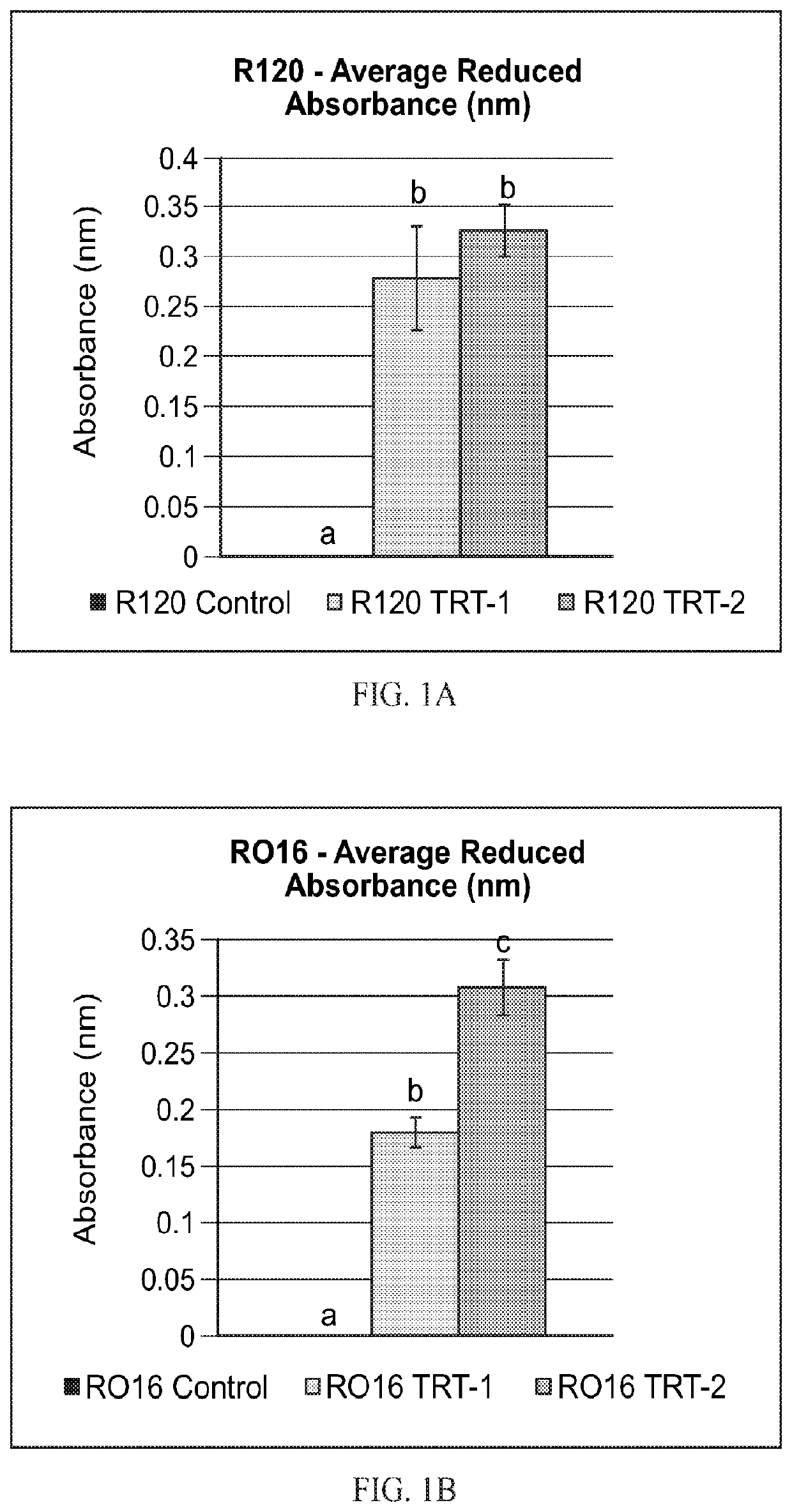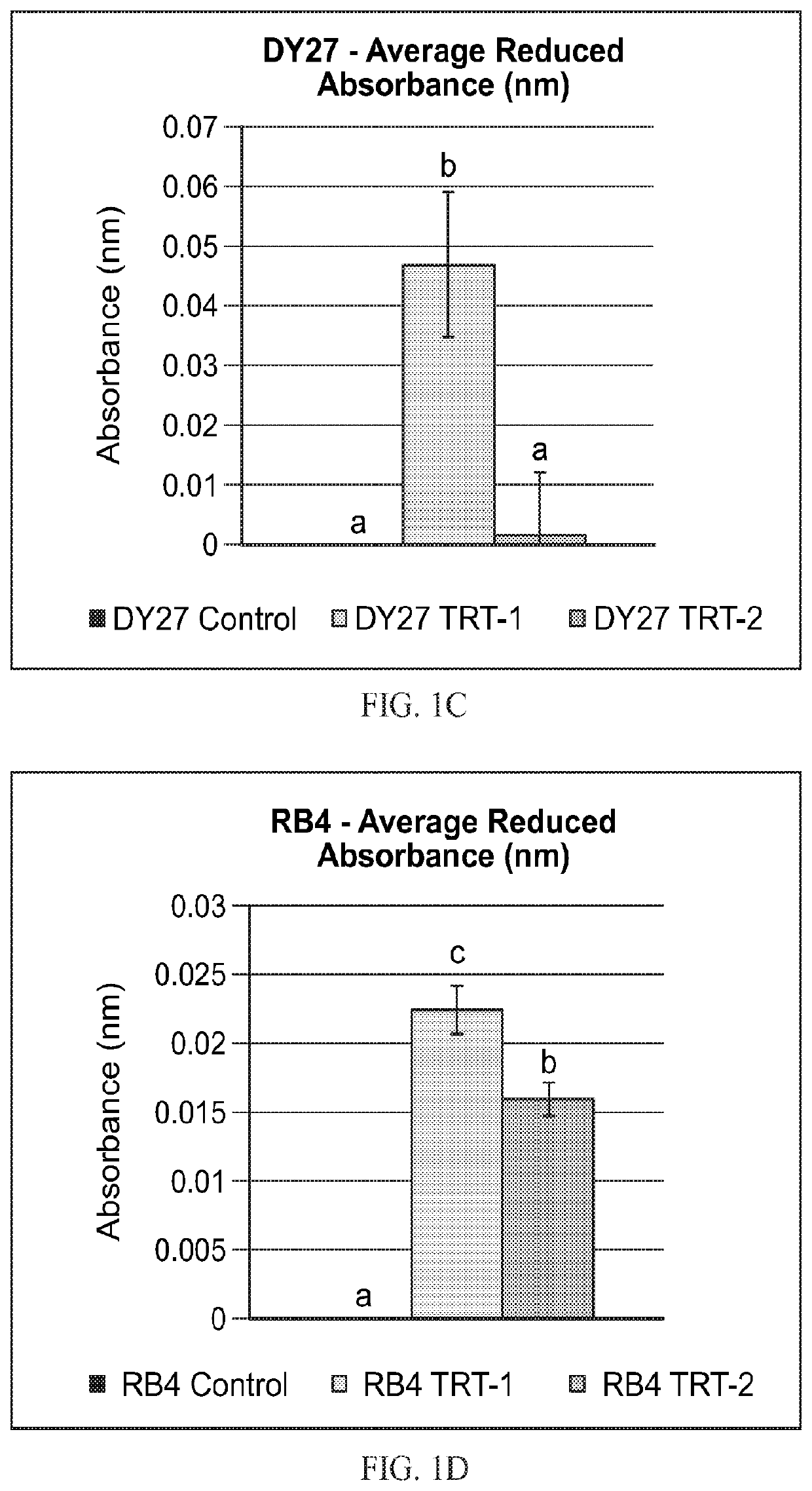Microorganisms for treatment of waste, water, or soil or for feeding to animals
a technology of microorganisms and waste water, applied in the direction of microorganisms, biological water/sewage treatment, specific water treatment objectives, etc., can solve the problems of increased light absorption and eutrophication, difficult to quantify the byproducts of lignin degradation, and acute toxicity
- Summary
- Abstract
- Description
- Claims
- Application Information
AI Technical Summary
Benefits of technology
Problems solved by technology
Method used
Image
Examples
example 1
Bioremediation of Colorants from Mineral Media
[0305]Lab-scale testing was conducted for triplicate experiments in mineral media with six separate colorants from Millipore Sigma: Reactive Red 120 (R120); Reactive Orange 16 (RO16); Direct Yellow 27 (DY27); Reactive Blue 4 (RB4); Reactive Black 5 (RB5); and Remazol Brilliant Blue R (RBBR). Dye stocks for each colorant were made by mixing dye with deionized water at 0.05%. Stocks were centrifuged and the upper phase was decanted to new tubes. Dye stocks were added to six jars of mineral medium at the following concentrations: 0.05% (w / v), 0.05% (w / v), 0.09% (w / v), 0.05% (w / v), 0.05% (w / v), and 0.05% (w / v), respectively, and sterilized at 121° C. for 30 minutes. Three preparations were made—a Control containing sterile mineral medium; Treatment-1 (TRT-1) including the mineral medium and MDG-1728; and Treatment-2 (TRT-2) including mineral medium and MDG-2705. The initial experiment was conducted in duplicate and the following were in quad...
example 2
Results and Analysis from Bioremediation of Colorants from Mineral Media
[0307]Results and analyses include outliers for each preparation (combined n=10). Controls were used to blank the spectrophotometer at the maximum wavelength (λmax) for each colorant; absorbance was measured for each treated preparation. All treated samples show statistical significance following one-way ANOVA with p-values <0.01; this excludes DY27 media with Treatment-2 where the p-value was insignificant (Table 1). The decrease in absorbance for each colorant and Treatment-1 (TRT-1) are as follows: R120=−0.28±0.05; RO16=−0.18±0.04; DY27=−0.05±0.04; RB4=−0.02±0.01; RB5=−0.10±0.03; and RBBR=−0.04±0.003. The decrease in absorbance for each colorant and Treatment-2 (TRT-2) are as follows: R120=−0.33±0.08; R016=−0.31±0.08; DY27=−0.002±0.03; RB4=−0.02±0.004; RB5=−0.14±0.006; and RBBR=−0.02±0.006. Results are graphed in FIGS. 1A-1F; error bars represent the standard error of the mean. The average pH following incuba...
example 3
Analysis of Lignin Peroxidase
[0308]Lab-scale testing was conducted to confirm quantitative lignin peroxidase production from MDG-1728 and MDG-2705 using 10-Acetyl-3,7 dihydroxyphenoxazine which, in the presence of peroxidase and excess hydrogen peroxide (H2O2), produces the fluorescent intermediate resorufin, which can be used to measure enzyme activity.
[0309]All reagents and inoculants were prepared prior to the experiment. MDG-1728 and MDG-2705 were grown in separate flasks in mineral medium+TSB, incubated for 72 hours, at 30° C., 150 rpm (pH=7.0). Culture was centrifuged, the upper phase decanted to Pierce Protein Concentrator tubes (PES, 100k MWCO, 5-20 mL). Concentrator tubes were centrifuged at 4000 rpm for 15 minutes, the supernatants was used as inoculants following harvest. The positive control consisted of 0.5 U / mL lignin peroxidase in 50 mM cold phosphate buffer (0.1 μm filter-sterile, pH 7.4); cooled to −20° C. A 10-Acetyl-3,7 dihydroxyphenoxazine stock solution was prep...
PUM
 Login to View More
Login to View More Abstract
Description
Claims
Application Information
 Login to View More
Login to View More - R&D
- Intellectual Property
- Life Sciences
- Materials
- Tech Scout
- Unparalleled Data Quality
- Higher Quality Content
- 60% Fewer Hallucinations
Browse by: Latest US Patents, China's latest patents, Technical Efficacy Thesaurus, Application Domain, Technology Topic, Popular Technical Reports.
© 2025 PatSnap. All rights reserved.Legal|Privacy policy|Modern Slavery Act Transparency Statement|Sitemap|About US| Contact US: help@patsnap.com



